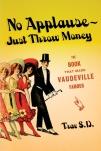![1935.13.680_1c[1]](https://travsd.files.wordpress.com/2011/08/1935-13-680_1c1.jpg?w=723) In America in the 19th century, as theatre historian Robert M. Lewis put it, “every program in the theatre was a variety show.” An evening’s entertainment, even a well-respected classical drama, was liable to be wrapped in a package of variety, with pre-shows, post-shows and entr’actes that could consist of anything from dancers to banjo players to opera singers to jugglers to opening prologues not so far removed from stand-up comedy. An 1838 bill featured Shakespeare, ballet, sentimental ballads, and an exhibition of the “Science of Gymnastics.” During her first American tour, for example, Sarah Bernhardt was discomfited to have the acts of her “Camille” broken up by can-can dancers and a xylophone player. New York’s Bowery was rife with this type of venue throughout the 19th century. F.F. Proctor built one of the first vaudeville chains out of such theatres in upstate New York in the early 1880s. By the 20th century, a complete split had taken place: vaudeville was vaudeville and legit was legit. The stratification was so great that vaudeville managers would have to haggle (and pay dearly) to convince stars Bernhardt, Ethyl Barrymore and Mrs. Patrick Campbell to stoop to do a turn on their stages.
In America in the 19th century, as theatre historian Robert M. Lewis put it, “every program in the theatre was a variety show.” An evening’s entertainment, even a well-respected classical drama, was liable to be wrapped in a package of variety, with pre-shows, post-shows and entr’actes that could consist of anything from dancers to banjo players to opera singers to jugglers to opening prologues not so far removed from stand-up comedy. An 1838 bill featured Shakespeare, ballet, sentimental ballads, and an exhibition of the “Science of Gymnastics.” During her first American tour, for example, Sarah Bernhardt was discomfited to have the acts of her “Camille” broken up by can-can dancers and a xylophone player. New York’s Bowery was rife with this type of venue throughout the 19th century. F.F. Proctor built one of the first vaudeville chains out of such theatres in upstate New York in the early 1880s. By the 20th century, a complete split had taken place: vaudeville was vaudeville and legit was legit. The stratification was so great that vaudeville managers would have to haggle (and pay dearly) to convince stars Bernhardt, Ethyl Barrymore and Mrs. Patrick Campbell to stoop to do a turn on their stages.
To learn more about the variety arts past and present, consult No Applause, Just Throw Money: The Book That Made Vaudeville Famous, available at Amazon, Barnes and Noble, and wherever nutty books are sold.

